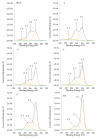Interfacial Adhesion and Mechanical Properties of Wood-Polymer Hybrid Composites Prepared by Injection Molding
- PMID: 34502888
- PMCID: PMC8434067
- DOI: 10.3390/polym13172849
Interfacial Adhesion and Mechanical Properties of Wood-Polymer Hybrid Composites Prepared by Injection Molding
Abstract
Birch (Betula pendula Roth.) and beech (Fagus sylvatica L.) solid wood and plywood were overmolded with polyamide 6 (PA 6) and polypropylene (PP) to investigate their mechanical properties and interfacial adhesion. In the case of PA 6, maximum tensile shear strengths values of more than 8 to 9 MPa were obtained for birch and beech, respectively. The values are comparable to bond strengths of commercial joints bonded with formaldehyde-containing amino-plastics. Perpendicular to the wood elements, bond strength values of 3 MPa was achieved for PA 6. The penetration of the polymers into the wood structure results in a non-densified interphase and subsequent plastic deformation of the wood structure beyond the interphase. These compressed areas influenced the interfacial adhesion and mechanical interlocking. SEM and XPS analysis revealed different interpenetration behavior of the polymers into the wood structure, with chemical interaction confirmed only for wood and PA 6 but not PP.
Keywords: XPS; interfacial bond strength; wood-polymer composites; wood-polymer interface.
Conflict of interest statement
The authors declare no conflict of interest.
Figures









References
-
- Leitgeb W., Kerschbichler S., Jost T., Mayrhofer P., Wagner W., Müller U. IHD, Konferenzproceedings—2. Interdisziplinäres Fahrzeugkolloquium; Dresden, Germany: 2016. Holz im strukturellen Fahrzeugbau; pp. 1–118.
-
- Statistisches Bundesamt. [(accessed on 16 August 2021)]; Available online: https://www.destatis.de/Europa/DE/Thema/Umwelt-Energie/CO2_Strassenverke....
-
- Mair-Bauernfeind C., Zimek M., Asada R., Bauernfeind D., Baumgartner R.J., Stern T. Prospective sustainability assessment: The case of wood in automotive applications. Int. J. Life Cycle Assess. 2020;25:2027–2049. doi: 10.1007/s11367-020-01803-y. - DOI
-
- Franzini F., Berghäll S., Toppinen A., Toivonen R. Comparing wood versus concrete: An explorative study of municipal civil servants’ beliefs about multistory building materials in Finland. For. Prod. J. 2021;71:65–76. doi: 10.13073/FPJ-D-20-00038. - DOI
-
- Asada R., Cardellini G., Mair-Bauernfeind C., Wenger J., Haas V., Holzer D., Stern T. Effective bioeconomy? A MRIO-based socioeconomic and environmental impact assessment of generic sectoral innovations. Technol. Forecast. Soc. Change. 2020;153:119946. doi: 10.1016/j.techfore.2020.119946. - DOI
Grants and funding
LinkOut - more resources
Full Text Sources
Miscellaneous

